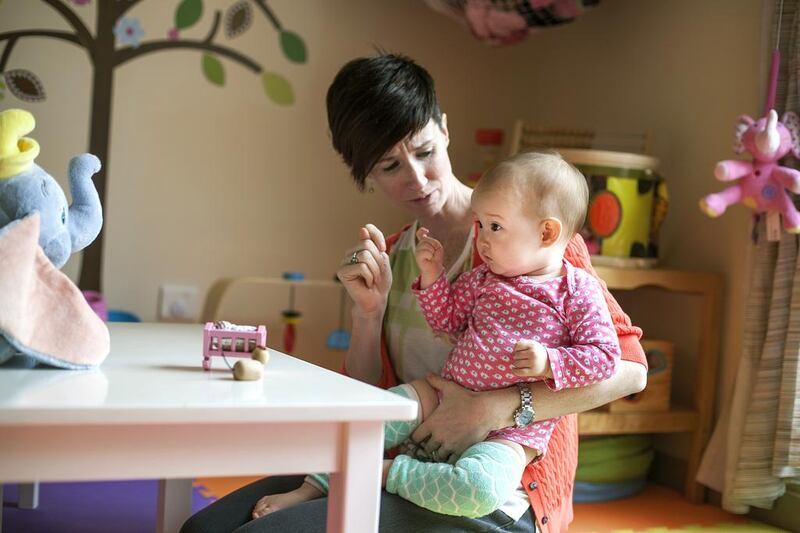Babies learn to communicate with simple signs such as blowing kisses and waving goodbye when they are as young as six months, but taking that a step further and teaching them sign language can open up a whole new channel of communication even before they learn to speak – and leads to fewer tantrums.
So believes Abu Dhabi-based mum Silvia Sopkova, from Slovakia, who is hosting a baby-signing workshop, using American Sign Language, for parents at the capital’s Bodytree Studio this weekend. Sopkova says she enjoys regular “chats” with her toddler Marko, 2, just like she used to when her older son Matteo, who is now 4, was a baby.
Sopkova started learning sign language when she was pregnant with her first child. By the time Matteo was 1, on a family trip to Slovakia, Sopkova was able to engage him in conversation.
“Everybody in Slovakia has a dog in their backyard, so Matteo made the sign for dog, all the time, by petting his leg. We were working on colours, so, he could say: ‘It’s a small brown dog’. A child not empowered by signing would not be able to put a whole sentence together at that age,” says Sopkova, adding that signing also works as a handy secret language. “We’ll be in a room full of people and I don’t need to shout: ‘Do you need the toilet?’ I’ll just sign it.”
American mum Casey D’Entremont, 33, began signing to her daughter, Aria, now a year old, a few weeks after she was born. The D’Entremont family, who live in Abu Dhabi’s Mangrove Village, use ASL.
“Aria first learnt the sign for milk,” says D’Entremont, who started learning ASL as a child so she could communicate with her hearing-impaired cousin. “I had this moment of ‘she gets it, she’s been listening to me and she knows that I’m listening to her’.”
Sopkova says there are benefits to teaching young babies how to sign, including preventing toddler tantrums.
“I often see children having tantrums because their parent doesn’t understand what they are trying to tell them,” says Sopkova. “The children who don’t know [how to] sign will try with their whole body to tell you what they want.”
Sopkova also likes the fact that sign language involves using facial expressions: “When you sign ‘grumpy’, you need to show ‘grumpy’. So it is creative – the way signing incorporates drama.”
Last month, British mum Soma Ward, 33, started offering baby-signing classes from her apartment in Al Reef. She discovered baby signing while living in Bahrain, when her son Dylan, who is now 3, was a baby. “I started attending baby- signing classes just as something to do with him, as I worked full-time as a teacher and the classes were the only activity offered for mums and babies at the weekends. I was just absolutely amazed by it – he started speaking very early and saying sentences quickly.”
Ross Thompson, a professor at University of California, Davis, whose work focuses on early-childhood development and who was in Abu Dhabi last month for a series of public talks on parenting, believes the jury is still out on the longer-term benefits of baby signing.
“There hasn’t been much research, yet. Some studies suggest it helps in language and cognitive development and others don’t reach that conclusion. But it’s also important to look at the affects of signing on the parent-child relationship – it helps parents to feel like they’re able to better understand what’s going on in their baby’s thinking. Parents are sometimes just overwhelmed at how aware their infants are, based on how they’re signing.”
Begin signing when your baby is 4 months old or younger, and make it a part of your daily routine. Remember to always say the word when you sign.
Milk – hold your fist in front of you and squeeze it.
More – put your fingertips together with both your hands and tap them a few times. This is a great sign to learn because children can use it with food, or when they want to play more.
Sleep – draw your hand across your face and close your eyes.
The website www.signingtime.com offers more than 30 award-winning ASL DVDs, as well as music CDs, flashcards and books.
artslife@thenational.ae





